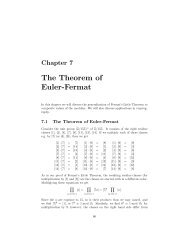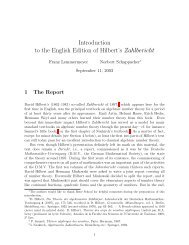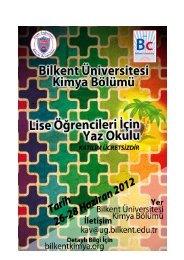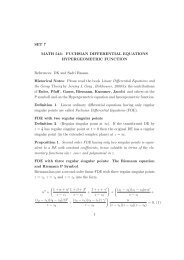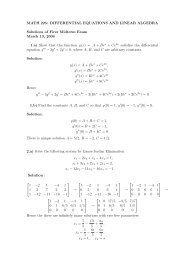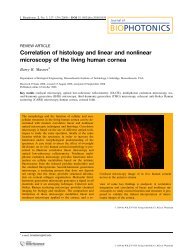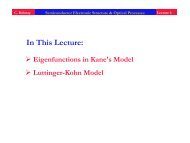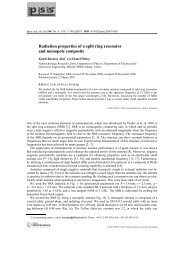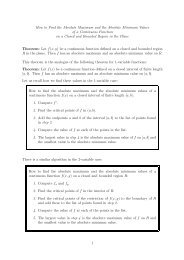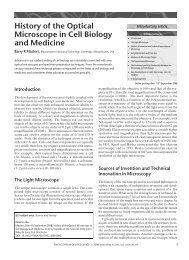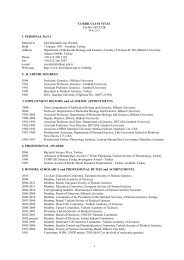Semiconductor Culture
Semiconductor Culture
Semiconductor Culture
Create successful ePaper yourself
Turn your PDF publications into a flip-book with our unique Google optimized e-Paper software.
C. Bulutay <strong>Semiconductor</strong> Electronic & Optical Processes<br />
Lecture 1<br />
In This Lecture:<br />
<strong>Semiconductor</strong> <strong>Culture</strong>: History, Trends
C. Bulutay <strong>Semiconductor</strong> Electronic & Optical Processes<br />
Lecture 1<br />
Basic <strong>Semiconductor</strong> <strong>Culture</strong><br />
1900-1940: Incubation period<br />
History of <strong>Semiconductor</strong> Physics<br />
Discovery of the electron(1899), photon (1905), QM (1925-28)<br />
F. Bloch – Ph.D. Thesis (1928), introduces band theory of metals<br />
R. Peierls (1929) conceives the theory of positive carriers to explain the thermal and<br />
electrical conductiveness of semiconductors.<br />
A.H. Wilson provides a theoretical understanding of se/c based on energy gap,<br />
further clarifying the holes/electrons, the role of impurities<br />
Fermi introduces pseudopotentials (vital for the development of band structure)<br />
se/c devices on the stage: thyristors & photodetectors<br />
1939-1945: WW-II<br />
1940-1945: Post-war disclosure; Microwave detection using se/c, QED, Lamb shift<br />
1947: Bardeen & Brattain demonstrate first bipolar transistor action<br />
1947: Bardeen points the importance of surface states in Schottky contacts<br />
1949: Shockley describes the physics of the p-n junction
C. Bulutay <strong>Semiconductor</strong> Electronic & Optical Processes<br />
Lecture 1<br />
History of <strong>Semiconductor</strong> Physics (cont’d)<br />
1950’s: se/c recognized as being versatile mat’ls; new devices follow<br />
1951: Shockley introduces heterojunctions<br />
1952: Shockley introduces junction FET<br />
1954: Townes invents maser after Dumke (1952) se/c laser proposal<br />
1958: Esaki’s tunnel diode (a marriage of QM & se/c physics)<br />
1958: Krömer’s NDR idea based on the effects of bandstructure on charge xport<br />
1960’s: Boom in theory (Keldysh, Kane, Kohn, Phillips, Cohen, Harrison,…)<br />
1962: Stimulated emission in GaAs diodes at GE & IBM labs (20 years more needed for<br />
an industrial maturity)<br />
1963: Gunn oscillations measured by Gunn; theory by Ridley-Watkins (1961)<br />
1970’s: Mainly large-size integration, first microprocessor, RTDs<br />
1970: Esaki & Tsui introduce superlattices & Bloch oscillations<br />
Early 1970’s: First Molecular Beam Epitaxy (MBE) at Bell Lab’s
C. Bulutay <strong>Semiconductor</strong> Electronic & Optical Processes<br />
Lecture 1<br />
History of <strong>Semiconductor</strong> Physics (cont’d)<br />
1980’s: Thanks to MBE, clean se/c samples; fundamental discoveries follow<br />
Weak localization and the rise of the mesoscopic physics<br />
Low-dimensional heterostructures (quantum wells & wires)<br />
1980: von Klitzing discovered QHE in pure MOSFETs (at mK); resistance standard<br />
1982: Tsui & Strömer discovered FQHE using very pure GaAs samples<br />
1987: Conductance quantization in quantum point contacts (Cambridge & Delft groups); Coulomb<br />
blockade<br />
1990’s: More advances in growth…<br />
Growth of Group-III Nitrides – Nakamura (1989-93)<br />
Synthesis of Carbon nanotubes – Ijima et al. (1991)<br />
Growth of Dilute Nitrides – Kondow et al.(1994)<br />
Growth of Self assembled quantum dots – Several groups (such as P. Petroff of UCSB)<br />
2000’s: The rise and rise of se/c physics…<br />
Silicon photonics – Pavesi<br />
Se/c quantum electrodynamics<br />
Quantum computing utilizing se/c QDs<br />
Spintronics – Spin Hall Effect experimentally demonstrated by UCSB group in 2004<br />
Molecular electronics & organic se/c<br />
Japanese Experimental<br />
Breakthrough
C. Bulutay <strong>Semiconductor</strong> Electronic & Optical Processes<br />
Lecture 1<br />
Trends in <strong>Semiconductor</strong> Research<br />
The period 1940-2000 was under the rule of information<br />
systems (high speed devices...)<br />
In 2000’s this monopoly is being weakened by other needs<br />
such as energy (solar cells, energy storage, etc.) and health<br />
(diagnostic and therapeutic tools)<br />
Some References on the History of <strong>Semiconductor</strong> Physics<br />
L. Hoddeson and G. Baym, ‘The development of the quntum-mechanical<br />
electron theory of metals: 1928-1933’, Reviews of Moden Physics, 59 287<br />
(1987).<br />
R. Peierls, ‘Early work on solids, mainly thirties’, Reviews of Moden<br />
Physics, 65 251 (1993).<br />
A. B. Fowler, ‘A semicentury of semiconductors’, Physics Today, p. 59<br />
(October, 1993)<br />
J. W. Orton, The story of semiconductors, (Oxford University Press, 2004)<br />
This book is available at our library: TK7871.85.O78 2004
C. Bulutay <strong>Semiconductor</strong> Electronic & Optical Processes<br />
Lecture 1<br />
How about the Future?<br />
Moore’s Law<br />
Source: J. Singh
C. Bulutay <strong>Semiconductor</strong> Electronic & Optical Processes<br />
Lecture 1<br />
Se/c industry roadmap<br />
Visit: International Technology Roadmap for <strong>Semiconductor</strong>s<br />
http://www.itrs.org<br />
NB: Main activity around CMOS technology<br />
Severe Challenges ahead<br />
Interconnect bottleneck<br />
Thermal Inferno<br />
In chip communication:<br />
Do it with Photons!<br />
Source: J. Singh
C. Bulutay <strong>Semiconductor</strong> Electronic & Optical Processes<br />
Lecture 1<br />
Classification of Electronic Materials<br />
Source: J. Singh<br />
E<br />
Semimetals<br />
k<br />
e.g., Bi, Sb, As,<br />
HgTe, HgSe
C. Bulutay <strong>Semiconductor</strong> Electronic & Optical Processes<br />
Lecture 1<br />
A typical se/c (EPM) bandstructure: GaN & AlN<br />
Conduction<br />
Bands<br />
Fermi<br />
level<br />
Band gap<br />
for GaN<br />
Valence<br />
Bands
C. Bulutay <strong>Semiconductor</strong> Electronic & Optical Processes<br />
Lecture 1<br />
Periodic Table<br />
Common se/c
C. Bulutay <strong>Semiconductor</strong> Electronic & Optical Processes<br />
Lecture 1<br />
A Classification of Se/c’s<br />
Elemental <strong>Semiconductor</strong>s<br />
Group-IV: Si, Ge; Diamond structure, tetrahedrally coordinated<br />
Group-V, VI: P, S, Se, Te are also se/c’s with several different crystal<br />
structures. Good glass formers<br />
Binary <strong>Semiconductor</strong>s<br />
III-V compounds are similiar to group IV<br />
IV → III-V ionicity increases. Electronic charge transfer from III to V<br />
atom: Coulomb interaction, changes in electronic band structure<br />
II-VI (ZnS): more ionic. Mostly large bandgaps → displays and lasers.<br />
Exception: HgTe zero bandgap → IR detectors.<br />
I-VII (CuCl): have larger bandgaps. Some are regarded as insulators.<br />
Increased cohesive energy. Rock salt struc.<br />
IV-VI (PbS, PbTe, SnS): semiconductors. Large ionicity. 6-fold<br />
coordination. Very small gaps. → IR detectors<br />
Ref: Yu-Cardona
C. Bulutay <strong>Semiconductor</strong> Electronic & Optical Processes<br />
Lecture 1<br />
A Classification of Se/c’s (Cont’d)<br />
Oxides<br />
CuO, CuO2 :semiconductors ZnO →transducer<br />
High Tc SC: Copper oxides: La2CuO4 → bandgap 2 eV.Dope with Ba or Sr.<br />
P-type.<br />
Layered <strong>Semiconductor</strong>s<br />
PbI2 , MoS2 , GaSe, GaS: Intraleyer bonding covalent, interlayer bonding van<br />
de Waals.<br />
Quasi 2-D.Intercalation.<br />
Organic <strong>Semiconductor</strong>s<br />
Polyacetylene [(CH2 ) n ], polydiacetylene<br />
LEDs, lasers? Displays. Cheap. Slow. Bandgap manipulation is easier.<br />
Magnetic <strong>Semiconductor</strong>s (gained further importance with spintronics)<br />
Magnetic ions: Mn, Eu etc. EuS, Cd1-xMnxTe: ferromag, antiferromag<br />
possible. Dilute mag se/c’s. Large Faraday rotation → optical modulators.<br />
Others<br />
SbSI: Ferroelectricy at low T,<br />
I-III-VI2 , II-IV-V2 : AgGaS2 and ZnSiP2 → chalcopyrite struc. Tetrahedral<br />
bonding. Analog to III-V and II-VI.<br />
IV-VI with formula such as As2Se3 : se/c’s in crystalline or glassy states<br />
Ref: Yu-Cardona
C. Bulutay <strong>Semiconductor</strong> Electronic & Optical Processes<br />
Lecture 1<br />
A Classification of Se/c’s (Cont’d)<br />
Ternary and Quaternary Se/c’s<br />
III x -III 1-x -V type ternaries:<br />
AlxGa1-xN, AlxGa1-xAs,AlxIn1-xP, AlxIn1-xSb, etc.<br />
III-V1-x-Vx type ternaries:<br />
AlAs1-xPx , GaAs1-xPx , InSb1 xAsx , InSb1-xBix , etc.<br />
IIIx-III1-x-Vy-V1-y , type Quaternaries:<br />
GaxIn1-xAsyP1-y , GaxIn1-xAsySb1 y , etc.<br />
III 1-x-y IIIx-IIIy-V type Quaternaries:<br />
In 1-x-y Al x Ga y P, In 1-x-y Al x Ga y As, etc.
C. Bulutay <strong>Semiconductor</strong> Electronic & Optical Processes<br />
Lecture 1<br />
Band gap vs. Photon Wavelength<br />
Surprise: dilute nitrides!<br />
Bandgap not linear interpolation<br />
Source: J. Singh
C. Bulutay <strong>Semiconductor</strong> Electronic & Optical Processes<br />
Lecture 1<br />
Comparison of se/s<br />
Source: J. Singh
C. Bulutay <strong>Semiconductor</strong> Electronic & Optical Processes<br />
Lecture 1<br />
Why insist on se/c ?<br />
Physical properties of se/c can be altered drastically by<br />
Doping<br />
Pressure<br />
Electric or magnetic field<br />
Light<br />
Temperature<br />
Response of se/c to external inputs can be tailored in a manner that allows<br />
the devices to implement all necessary information processing operations<br />
Digital & analog signal processing<br />
Oscillators<br />
Detectors<br />
Memories<br />
…<br />
Industrial conservatism; huge investments and acquired knowledge
C. Bulutay <strong>Semiconductor</strong> Electronic & Optical Processes<br />
Lecture 1<br />
Why insist on se/c ?<br />
Electrons have:<br />
charge → interact strongly<br />
Good for information processing/computation (digital/analog)<br />
But they interact strongly among themselves and the environment, hence they<br />
are prone to noise<br />
mass → they suffer from propagation delays (drift velocity in se/c ~ 10 7 cm/s)<br />
Photons have:<br />
no mass, no charge → very weak interaction<br />
Ideal for signal transmission as they are fast and hardly interact with each other<br />
But, it is also harder to operate on them as in the case of electrons<br />
<strong>Semiconductor</strong> structures are ideal for hosting both electrons & photons!
C. Bulutay <strong>Semiconductor</strong> Electronic & Optical Processes<br />
Lecture 1<br />
Demands on se/s<br />
Source: J. Singh


